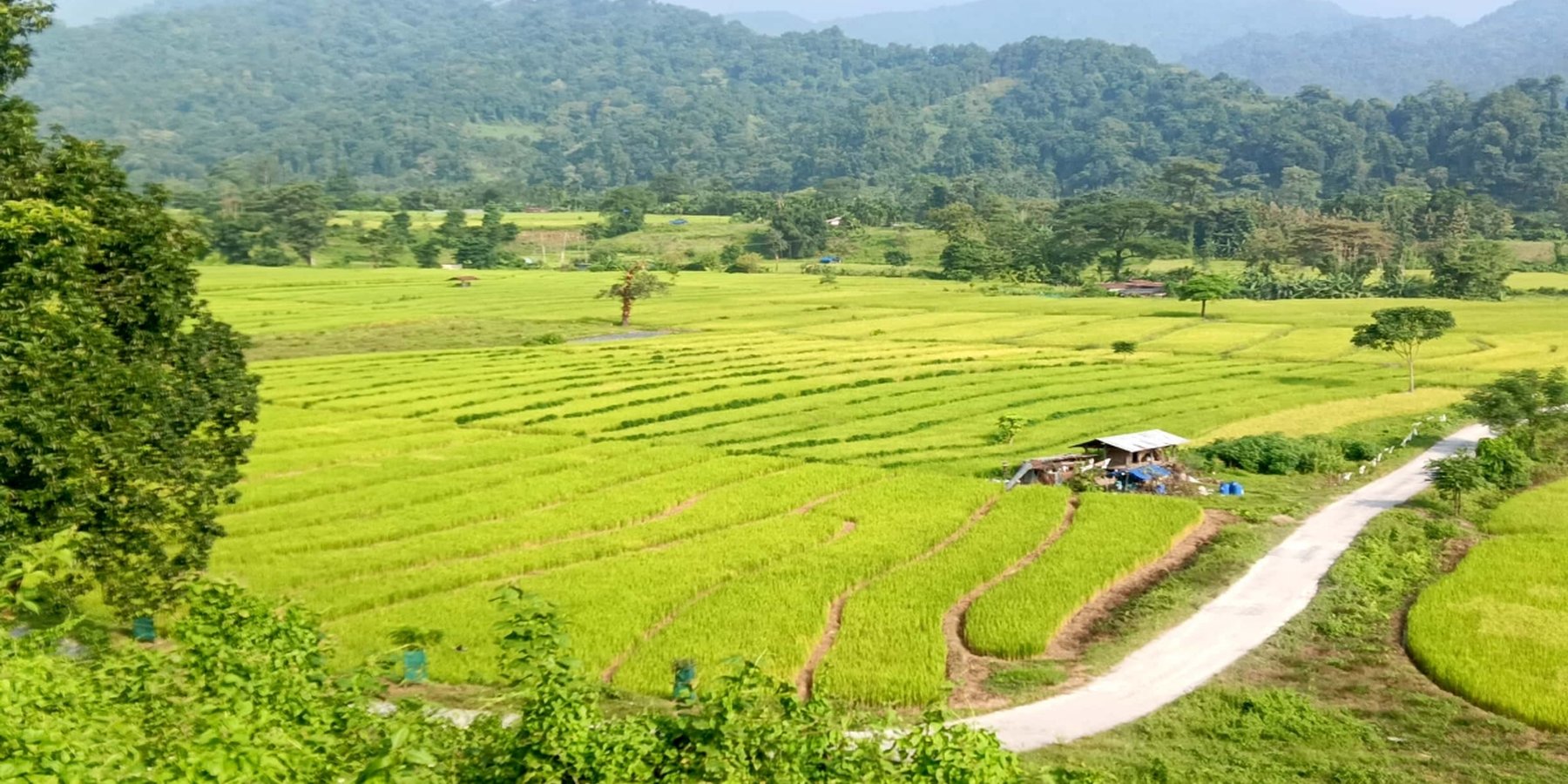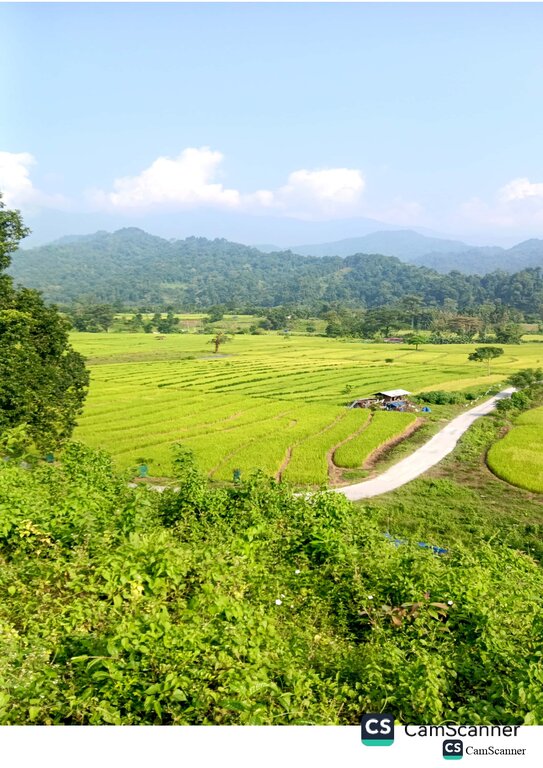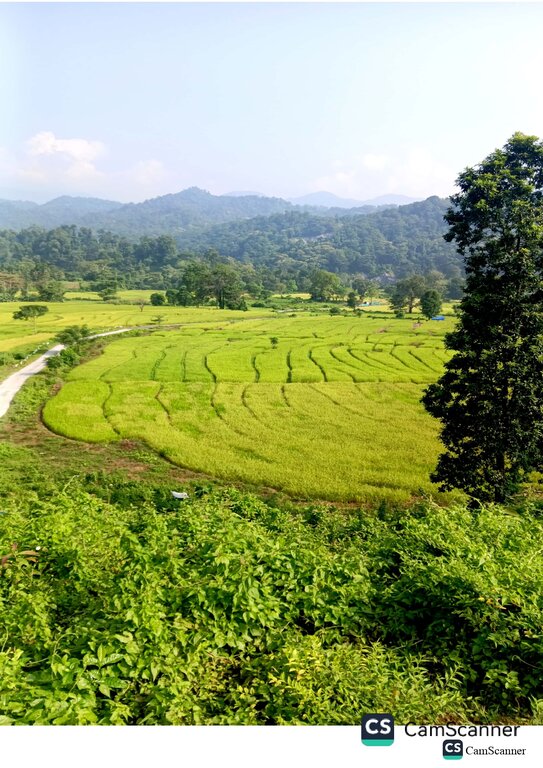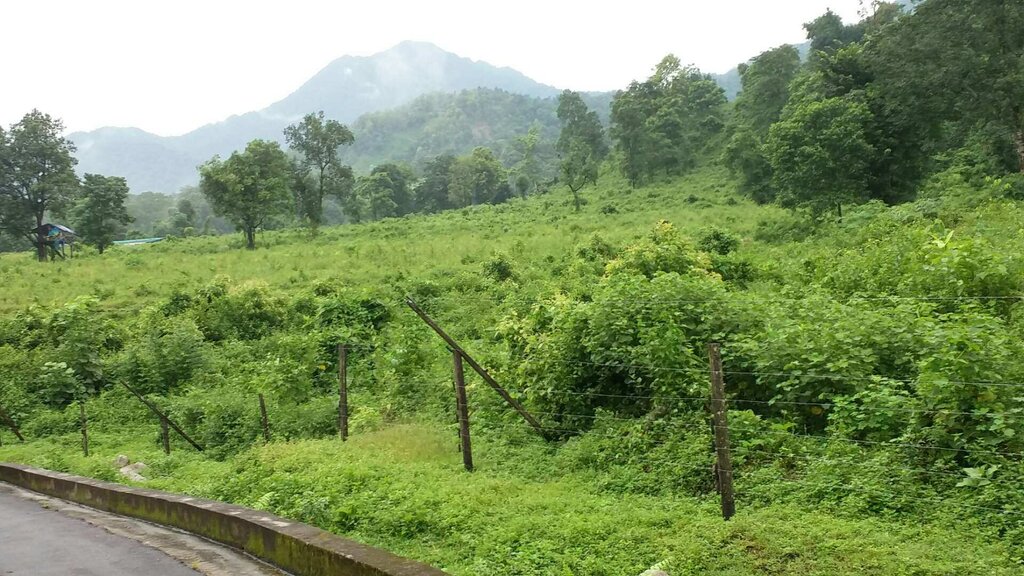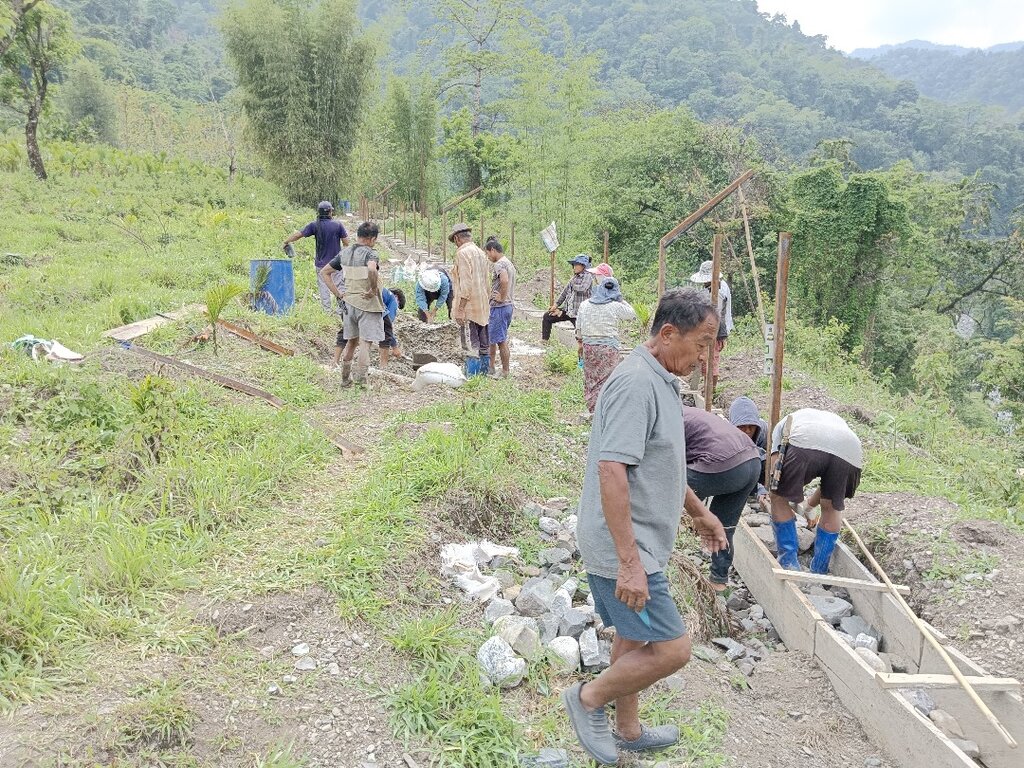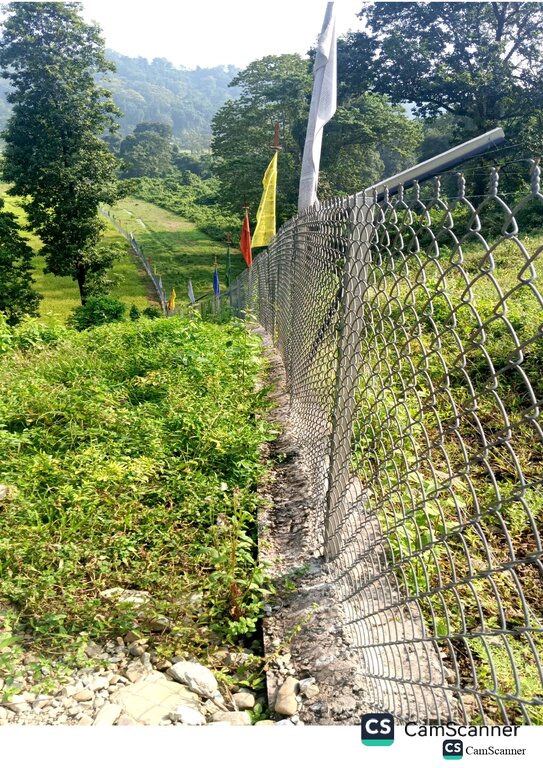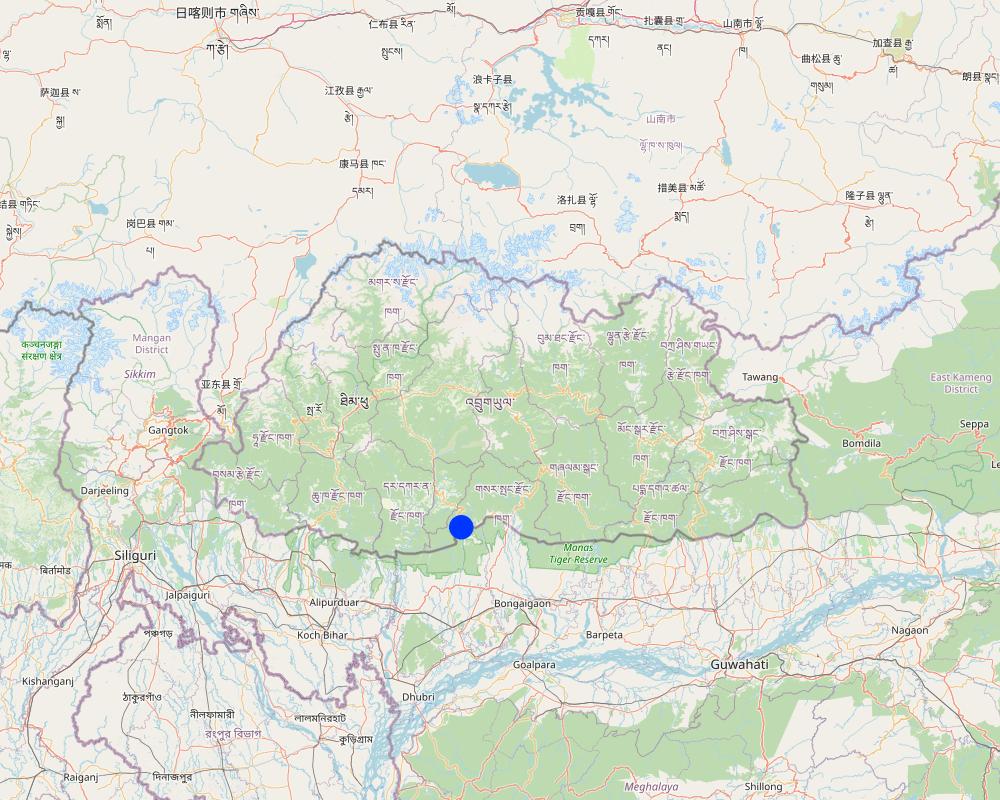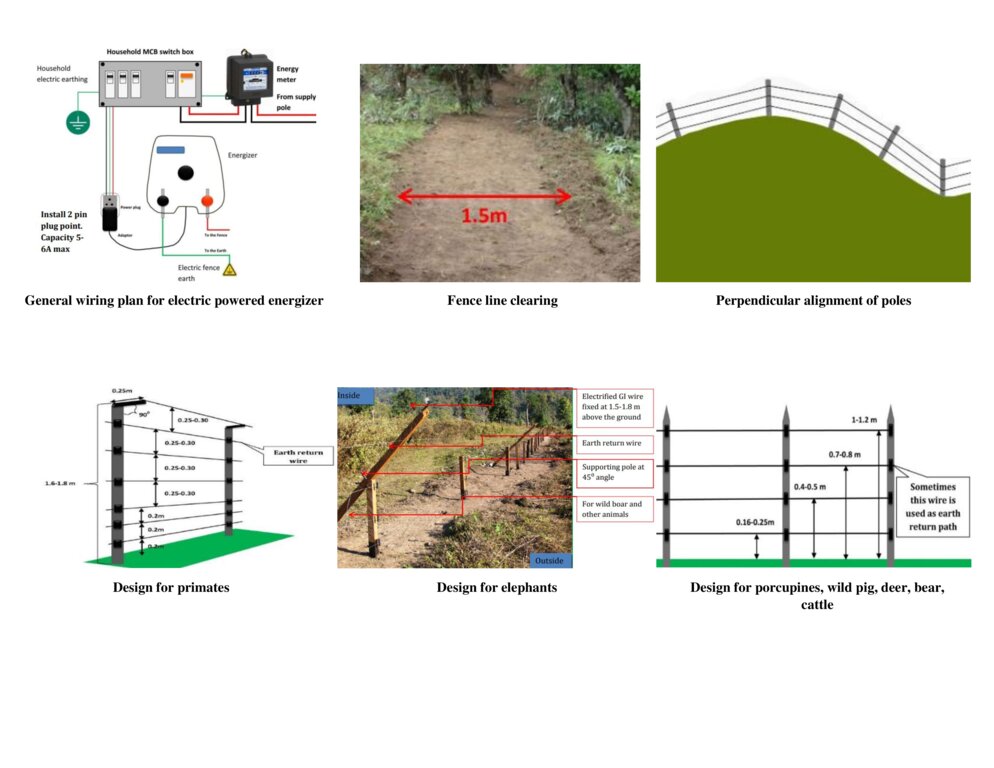Securing Food Through Electric Fencing [Bhoutan]
- Création :
- Mise à jour :
- Compilateur : Nima Dolma Tamang
- Rédacteur : Chenga Tshering
- Examinateurs : William Critchley, Rima Mekdaschi Studer
gLog-May-Raow
technologies_6830 - Bhoutan
Voir les sections
Développer tout Réduire tout1. Informations générales
1.2 Coordonnées des personnes-ressources et des institutions impliquées dans l'évaluation et la documentation de la Technologie
Personne(s)-ressource(s) clé(s)
exploitant des terres:
Tashi Tshering
Bhoutan
Gewog Agriculture Extension Officer:
Wangdi Thinley
Gewog Agriculture office, Senggye Gewog, Sarpang Dzongkhag
Bhoutan
Nom du projet qui a facilité la documentation/ l'évaluation de la Technologie (si pertinent)
Strengthening national-level institutional and professional capacities of country Parties towards enhanced UNCCD monitoring and reporting – GEF 7 EA Umbrella II (GEF 7 UNCCD Enabling Activities_Umbrella II)Nom du ou des institutions qui ont facilité la documentation/ l'évaluation de la Technologie (si pertinent)
National Soil Services Centre, Department of Agriculture, Ministry of Agriculture & Livestock (NSSC) - Bhoutan1.3 Conditions relatives à l'utilisation par WOCAT des données documentées
Le compilateur et la(les) personne(s) ressource(s) acceptent les conditions relatives à l'utilisation par WOCAT des données documentées:
Oui
1.4 Déclaration sur la durabilité de la Technologie décrite
Est-ce que la Technologie décrite ici pose problème par rapport à la dégradation des terres, de telle sorte qu'elle ne peut pas être déclarée comme étant une technologie de gestion durable des terres?
Non
Commentaires:
Based on the responses provided by the interviewee (Group Chairman), it appears that electric fences may not directly contribute to mitigating land degradation. However, they can be considered as part of a technological approach, particularly in terms of adaptation, given their effectiveness in land restoration, fallow land reversion, ensuring food security, and ultimately enhancing livelihoods.
2. Description de la Technologie de GDT
2.1 Courte description de la Technologie
Définition de la Technologie:
The Electric Fencing System in Bhutan serves as a non-lethal approach to safeguarding crops from wild animals, aligning with the principles of Gross National Happiness (GNH). GNH emphasizes values such as compassion, non-killing, and harmonious coexistence with nature and its elements.
2.2 Description détaillée de la Technologie
Description:
The Electric Fencing System in Bhutan serves as a non-lethal approach to safeguarding crops from wild animals, aligning with the principles of Gross National Happiness (GNH). GNH emphasizes values such as compassion, non-killing, and harmonious coexistence with nature.
The National Plant Protection Centre (NPPC), Department of Agriculture (DoA), Ministry of Agriculture and Livestock (MoAL) has been facilitating the application and installation of electric fence systems nationwide. This is achieved through the provision of comprehensive guidelines to help the public comprehend the fundamental components and installation procedures.
In essence, the electric fence system consists of three major parts: Energizers, Insulators, and Earth return. The energizer is responsible for generating high-voltage pulse electricity (ranging from 9-12 KV), which is then delivered along the fence wires. The majority of energizers are directly connected to the electricity line, while in some isolated cases, solar panels and batteries are used as alternative power sources. Insulators are typically crafted from a non-conductive material and serve as a barrier between the electrified wire and the wooden post. In the Bhutanese market, these insulators are not readily available, thus as an alternative, high-density polyethylene (HDPE) pipe has been found to be effective and cheap. The electric fence earth return serves as an essential pathway in the electric circuit, collecting high voltage and current from the earth and returning it to the energizer.
The loss of crops to wild animals leads to increased production costs in Bhutan (time spent in crop guarding) and the expansion of fallow lands. Farmers often resort to illegal and fatal methods of electric fencing, tapping electricity directly from the main line. To address these issues, the implementation of electric fencing, utilizing imported IEC-certified energizers and locally fabricated fencing materials, has proven to be successful. This electric fencing system, introduced after five years of pre-testing across the country, covers various locations targeting different problem species of animals. Not only is this technology effective in controlling wild pests, but it also enjoys high social acceptance among Bhutanese farmers due to its cost-effectiveness and being non-lethal to wild pests.
A recent study on the impact of electric fencing on food security focused on the Laptsakha community in Senggye Gewog, Sarpang Dzongkhag. They faced threats to food security from elephants, boar and stray cattle from neighboring communities in India. Crop production in Laptsakha was negligible before the introduction of electric fencing: resettled households contemplated returning, fertile lands were left fallow, and incomes shrank. The turning point came in 2013 with the introduction of electric fencing. This intervention successfully mitigated wildlife attacks on crops, ensuring food security and contributing to a harmonious ecosystem and improved livelihoods for the people of Laptsakha.
The electric fence, covering a distance of 7 km, protects a total of 60 households in all, safeguarding about 60 (24 ha) acres of vulnerable lands. Electric fences have various benefits including:
•Harmonious Approach: they do not cause harm to animals beyond a repellent shock.
•Economical and Easy to Build: they are cost-effective and relatively easy to construct.
•Learning and Deterrence: animals quickly learn to respect electric fences.
•Durability: they have an extended service life.
•Versatility: they offer a variety of designs and can control a wide range of wild animals.
The installation of an electric fence involves a participatory approach and several key steps:
•Location and Length: determine the location and approximate length of the electric fence either by manual measurement, or remote technologies for larger expanses.
•Material Estimation: estimate the required materials per kilometre based on the identified area, including wooden poles, HDPE pipe, and GI wire.
•Additional Materials: Consider other essential materials like energizers, solar panels, charge controllers, and batteries, depending on the specific requirements.
•Cost Estimation: Calculate the cost of installation, which varies regionally. For example, to instal one kilometre of an electric fence is estimated at about Nu. 7,450 (USD 95) excluding labour costs and cost of wooden poles which is sourced locally.
The implementation of electric fencing in the community has brought significant advantages, particularly in securing food. Prior to this intervention, the community faced severe challenges in harvesting crops, with approximately 70% of fertile lands being left fallow due to constant human-wildlife conflicts. Crop guarding became routine & risky.
With the introduction of electric fences, the community's agricultural landscape has undergone a positive transformation. Crop diversification has been enhanced, encompassing maize, ginger, paddy, mandarin fruit trees and areca nut. The frequency of wild elephant attacks has significantly decreased, leading to a notable increase in crop production. This has resulted in secured food sources and improved livelihoods. Additionally, the community has successfully revived previously fallow lands.
While the electric fencing has proven effective, there are challenges faced by the land users, notably the frequent damage to energizers, primarily attributed to thunderstorms. This has resulted in higher maintenance costs. In one specific instance, the community had to mobilize approximately Nu. 145,000 (USD 1800) independently to replace damaged energizers and other materials, supplementing the continued support from the government.
2.3 Photos de la Technologie
2.5 Pays/ région/ lieux où la Technologie a été appliquée et qui sont couverts par cette évaluation
Pays:
Bhoutan
Région/ Etat/ Province:
Sarpang Dzongkhag
Autres spécifications du lieu:
Laptsakha Village, Senggye Gewog
Spécifiez la diffusion de la Technologie:
- appliquée en des points spécifiques ou concentrée sur une petite surface
Est-ce que les sites dans lesquels la Technologie est appliquée sont situés dans des zones protégées en permanence?
Oui
Si oui, veuillez préciser:
The Laptsakha community (electric fencing site) falls under Phibsoo Wildlife Sanctuary.
Commentaires:
The Phibsoo Wildlife Sanctuary, situated in western Sarpang Dzongkhag and south-eastern Dagana Dzongkhag along the border with West Bengal, is the second-smallest national park in Bhutan, covering an area of 268.93 square kilometers. This sanctuary is linked to Jigme Singye Wangchuck National Park and Royal Manas National Park through a biological corridor that crosses a national highway. The elevations within the sanctuary range from 200 meters to 1,600 meters.
Map
×2.6 Date de mise en œuvre de la Technologie
Indiquez l'année de mise en œuvre:
2013
2.7 Introduction de la Technologie
Spécifiez comment la Technologie a été introduite: :
- par le biais de projets/ d'interventions extérieures
Commentaires (type de projet, etc.) :
The electric fencing program in the community was facilitated by the former Renewable Natural Resources and Development Centre (RNR-DC) - Yusipang, now known as the National Center for Organic Agriculture- Yusipang. Additionally, the expertise of the electric fence specialist from ARDC - Wengkhar, Mongar (Eastern Bhutan) was involved in the implementation of the program.
3. Classification de la Technologie de GDT
3.1 Principal(aux) objectif(s) de la Technologie
- améliorer la production
- réduire, prévenir, restaurer les terres dégradées
- conserver/ améliorer la biodiversité
- créer un impact économique positif
- créer un impact social positif
3.2 Type(s) actuel(s) d'utilisation des terres, là où la Technologie est appliquée
Les divers types d'utilisation des terres au sein du même unité de terrain: :
Oui
Précisez l'utilisation mixte des terres (cultures/ pâturages/ arbres):
- Agroforesterie

Terres cultivées
- Cultures annuelles
- Cultures pérennes (non ligneuses)
Cultures annuelles - Précisez les cultures:
- céréales - maïs
- céréales - mil
- céréales - riz (de terres humides)
Cultures pérennes (non ligneuses) - Précisez les cultures:
- noix d'arec
- ananas
- Banana, cardamom
Nombre de période de croissance par an: :
- 2
Précisez:
Maize in summer is followed by chilli in winter.
Est-ce que les cultures intercalaires sont pratiquées?
Oui
Si oui, précisez quelles cultures sont produites en culture intercalaire:
The people of Laptsakha cultivate paddy (wetland) and soybean simultaneously. The soybean is grown along the terrace bunds, especially as a border crop.
Est-ce que la rotation des cultures est appliquée?
Oui
Si oui, veuillez préciser:
The maize harvest is followed by chilli cultivation

Forêts/ bois
- Forêts (semi-)naturelles/ bois
Forêts (semi-)naturelles/ terres boisées: précisez le mode de gestion:
- Coupes sélectives
- Utilisation de la forêt non liée au bois
Type de forêts (semi)-naturelles:
- végétation naturelle des forêts humides subtropicales
- Mixed broad leaves
Est-ce que les espèces d’arbres précisées ci-dessus sont des espèces d'arbre arbres à feuilles caduques ou à feuilles persistantes ?
- forêt mixte décidue/ à feuillage persistant
Produits et services:
- Bois d'œuvre (de construction)
- Bois de chauffage
- Pâturage/ broutage
3.3 Est-ce que l’utilisation des terres a changé en raison de la mise en œuvre de la Technologie ?
Est-ce que l’utilisation des terres a changé en raison de la mise en œuvre de la Technologie ?
- Non (Passez à la question 3.4)
Commentaires:
The introduction of electric fencing in the community has not led to a change in land use patterns. However, there has been a notable transformation in land cover over the years. Prior to the implementation of electric fencing, approximately 70% of the currently cultivated lands (comprising 325 acres, including 168 acres of dry land and 157 acres of wetland) were left fallow due to the threat of wildlife (human-wildlife conflict). The introduction of electric fencing has played a crucial role in revitalizing these fertile fallow lands, bringing them back into cultivation.
3.4 Approvisionnement en eau
Approvisionnement en eau des terres sur lesquelles est appliquée la Technologie:
- mixte: pluvial-irrigué
Commentaires:
The community is well-equipped with two full-time irrigation sources: Mahajan Irrigation and Ghantay Irrigation canals. However, the reliance on irrigation is reduced when there is sufficient rainfall. Therefore, they describe the irrigation system as a mixed approach, combining both irrigation sources and rainwater.
3.5 Groupe de GDT auquel appartient la Technologie
- gestion des forêts naturelles et semi-naturelles
- lutte intégrée contre les ravageurs et les maladies (incluant l'agriculture biologique)
- gestion/ protection des zones humides
3.6 Mesures de GDT constituant la Technologie

structures physiques
- S6: Murs, barrières, palissades, clôtures
- S10: Mesures d'économie d'énergie
Commentaires:
The electric fence can be a structural measure that ensures energy savings due to its versatility (solar and electric-power options). It can be also considered as one of the structural measures ensuring a harmonious environment.
3.7 Principaux types de dégradation des terres traités par la Technologie

dégradation biologique
- Bc: réduction de la couverture végétale
- Bh: perte d’habitats
- Bq: baisse de la quantité/ biomasse
Commentaires:
The electric fencing ensures harmonious environment for wild life. Their lives are prevented from fatal threats being attempted by farmers in controlling wild pests. Hence, they are dedicated with the safe habitats, which ultimately results in enhanced bio-diversity.
3.8 Prévention, réduction de la dégradation ou réhabilitation des terres dégradées
Spécifiez l'objectif de la Technologie au regard de la dégradation des terres:
- prévenir la dégradation des terres
- réduire la dégradation des terres
Commentaires:
The electric fence plays an important role in preventing and reducing land degradation. The lands encompassed within the electric fence are well managed and put to good use (higher ground coverage with year-round cultivation, proper nutrient management, and others). Caring for these productive lands encircled by electric fencing thereby either prevents or reduces land degradation ultimately.
4. Spécifications techniques, activités, intrants et coûts de mise en œuvre
4.1 Dessin technique de la Technologie
Spécifications techniques (associées au dessin technique):
Insulators are prepared using HDPE pipes (32 mm or 25 mm in diameter, with a pressure capacity of 10 kg/cm2). These pipes are cut into 10-11 cm lengths, with holes drilled at the center, and then secured with two 3-inch nails at both ends, maintaining a 1.50 cm distance from edges. The fencing process involves clearing a fence line with a width of at least 1.5 m. Wooden poles (10 to 18 cm in diameter) are erected perpendicular to the ground, spaced 2.5 to 3 m apart in flat lands and 2 m or less in sloped areas.
For fences designed to control smaller species like rabbits and porcupines, the first wire is positioned about 0.14 to 0.16 m from the ground. Fences for larger animals such as wild boars, deer, and bears require 3 to 4 strands of wires positioned at 0.25, 0.4 to 0.5, 0.7 to 0.8, and 1 to 1.2 m from the ground. In the case of elephants, one or two strands of wire should be positioned at 1.5 to 1.8 m from the ground, and supporting poles should be erected at 45-degree angles from the entrance side of the field.
The height of the fence is adapted based on the target animals, such as monkeys. Typically, the 7th strand is supported on a 25 cm HDPE pipe fixed on top of the wooden pole at a 90-degree angle to the entrance side of the field. This design prevents monkeys from climbing the wooden posts and jumping into the field.
Auteur:
National Plant Protection Centre (NPPC), DoA, MoAL
Date:
08/07/2023
4.2 Informations générales sur le calcul des intrants et des coûts
Spécifiez la manière dont les coûts et les intrants ont été calculés:
- par entité de la Technologie
Précisez l'unité:
kilometre
autre/ monnaie nationale (précisez):
Ngultrum (Nu.)
Indiquez le taux de change des USD en devise locale, le cas échéant (p.ex. 1 USD = 79.9 réal brésilien): 1 USD = :
80,0
Indiquez le coût salarial moyen de la main d'œuvre par jour:
250
4.3 Activités de mise en place/ d'établissement
| Activité | Calendrier des activités (saisonnier) | |
|---|---|---|
| 1. | Area identification through Google Map by ARDC-Yusipang | 2013, Winter |
| 2. | Cleaning of vegetation along the identified fence line (10 m width) | 2013, Winter (after crop harvest) |
| 3. | Ground clearing and levelling (2 m width) | 2013, Winter (after crop harvest) |
| 4. | Gathering of fencing poles | 2013, Winter (after crop harvest) |
| 5. | Procurement and facilitation of materials (energizers, solar panels, nails, GI wire, insulation pipes) | 2013, Winter (after crop harvest) |
| 6. | Execution of fencing activities | 2013, Winter (after crop harvest) |
Commentaires:
The actual electric fencing works in Laptsakha, measuring a distance of seven kilometres was completed in less than a month. Better community cooperation was a major reason behind this success, as per the Group's chairman.
4.4 Coûts et intrants nécessaires à la mise en place
| Spécifiez les intrants | Unité | Quantité | Coûts par unité | Coût total par intrant | % du coût supporté par les exploitants des terres | |
|---|---|---|---|---|---|---|
| Main d'œuvre | Man | Person-days | 1600,0 | 250,0 | 400000,0 | 100,0 |
| Equipements | Energizer | No. | 6,0 | 9500,0 | 57000,0 | |
| Equipements | GI wire (SWG 16) | Kg | 356,0 | 95,0 | 33820,0 | |
| Equipements | Nail (3 inch) | Kg | 106,0 | 82,0 | 8692,0 | |
| Equipements | Solar Panel (20 watts) | No. | 6,0 | 7000,0 | 42000,0 | |
| Equipements | Charge controller | No. | 6,0 | 1800,0 | 10800,0 | |
| Equipements | Acidic Battery | No. | 6,0 | 2800,0 | 16800,0 | |
| Equipements | Lubricants (Gear oil) | Litre | 6,0 | 254,0 | 1524,0 | |
| Equipements | Insulators (HDPE pipe [32 mm]) | Metre | 781,0 | 48,0 | 37488,0 | |
| Matériaux de construction | Wooden poles | No. | 1400,0 | 100,0 | ||
| Autre | Other accessories | NA | 1,0 | 1000,0 | 1000,0 | |
| Coût total de mise en place de la Technologie | 609124,0 | |||||
| Coût total de mise en place de la Technologie en dollars américains (USD) | 7614,05 | |||||
Si le coût n'est pas pris en charge à 100% par l'exploitant des terres, indiquez qui a financé le coût restant:
National Centre for Organic Agriculture, Yusipang
Commentaires:
The labour contribution was from Laptsakha and Nichula villages as the electric fencing benefitted both villages. Therefore, a higher number of land users are involved in the construction of the technology.
The total cost for the establishment of the technology is USD 7614.05 for 7 km (USD 1087.7 for 1 km). This includes labour cost which is borne by the land users.
4.5 Activités d'entretien/ récurrentes
| Activité | Calendrier/ fréquence | |
|---|---|---|
| 1. | Replacement of energizers during breakdowns | As and when breakdown occurs |
| 2. | Fence line clearing | Monthly |
Commentaires:
Between 2013 and 2019, approximately 20 energizer sets had to be replaced due to thunderstorm damage. To address this issue, the community transitioned to using solar-powered energizers instead of electricity, proving to be a more effective solution. Double batteries were employed to ensure consistent current flow during cloudy days. As part of the routine maintenance, the clearing of the fence line became a monthly task, with each household assigned an area of approximately 116 meters to manage.
4.6 Coûts et intrants nécessaires aux activités d'entretien/ récurrentes (par an)
| Spécifiez les intrants | Unité | Quantité | Coûts par unité | Coût total par intrant | % du coût supporté par les exploitants des terres | |
|---|---|---|---|---|---|---|
| Main d'œuvre | Labor | Person-days | 59,0 | 700,0 | 41300,0 | 100,0 |
| Coût total d'entretien de la Technologie | 41300,0 | |||||
| Coût total d'entretien de la Technologie en dollars américains (USD) | 516,25 | |||||
Si vous n'êtes pas en mesure de décomposer les coûts dans le tableau précédent, donnez une estimation du coût total de l'entretien de la Technologie:
145000,0
Commentaires:
The beneficiaries covered the cost of acquiring the damaged energizers through monthly contributions of Nu. 200 per household and other penalty revenues. The total costs for maintenance of the technology is USD 516.25 for 7 km ( USD 73.75 for 1 km).
4.7 Facteurs les plus importants affectant les coûts
Décrivez les facteurs les plus importants affectant les coûts :
The primary factor incurring the cost, according to the beneficiaries, was the energizer set, which necessitates frequent replacement.
5. Environnement naturel et humain
5.1 Climat
Précipitations annuelles
- < 250 mm
- 251-500 mm
- 501-750 mm
- 751-1000 mm
- 1001-1500 mm
- 1501-2000 mm
- 2001-3000 mm
- 3001-4000 mm
- > 4000 mm
Spécifications/ commentaires sur les précipitations:
The most recent climate data 2017, published by NCHM was used.
Indiquez le nom de la station météorologique de référence considérée:
Station: Bhur, Type: Class A, Station ID: 23310046
Zone agro-climatique
- humide
The area falls under the humid subtropical zone from the six Agro-ecological zones in Bhutan.
5.2 Topographie
Pentes moyennes:
- plat (0-2 %)
- faible (3-5%)
- modéré (6-10%)
- onduleux (11-15%)
- vallonné (16-30%)
- raide (31-60%)
- très raide (>60%)
Reliefs:
- plateaux/ plaines
- crêtes
- flancs/ pentes de montagne
- flancs/ pentes de colline
- piémonts/ glacis (bas de pente)
- fonds de vallée/bas-fonds
Zones altitudinales:
- 0-100 m
- 101-500 m
- 501-1000 m
- 1001-1500 m
- 1501-2000 m
- 2001-2500 m
- 2501-3000 m
- 3001-4000 m
- > 4000 m
Indiquez si la Technologie est spécifiquement appliquée dans des:
- non pertinent
Commentaires et précisions supplémentaires sur la topographie:
The gentle plain dominates the area with a slope ranging from 2 to 5 per cent.
5.3 Sols
Profondeur moyenne du sol:
- très superficiel (0-20 cm)
- superficiel (21-50 cm)
- modérément profond (51-80 cm)
- profond (81-120 cm)
- très profond (>120 cm)
Texture du sol (de la couche arable):
- grossier/ léger (sablonneux)
Texture du sol (> 20 cm sous la surface):
- grossier/ léger (sablonneux)
Matière organique de la couche arable:
- abondant (>3%)
Si disponible, joignez une description complète du sol ou précisez les informations disponibles, par ex., type de sol, pH/ acidité du sol, capacité d'échange cationique, azote, salinité, etc.
Moisture content 3.31%, organic matter 7.16%, Organic carbon 4.16%, pH 6.81, electrical conductivity 261.97 µs/cm, nitrogen 0.21%, phosphorus 0.34 ppm, Potassium 201.07 mg/100ml, texture sand clay loam.
The soil analysis was conducted at the Science Laboratory of College of Natural Resources, Royal University of Bhutan, Lobesa, Punakha.
5.4 Disponibilité et qualité de l'eau
Disponibilité de l’eau de surface:
bonne
Qualité de l’eau (non traitée):
eau potable
La qualité de l'eau fait référence à:
eaux de surface
La salinité de l'eau est-elle un problème? :
Non
La zone est-elle inondée?
Non
5.5 Biodiversité
Diversité des espèces:
- élevé
Diversité des habitats:
- élevé
Commentaires et précisions supplémentaires sur la biodiversité:
The rich periphery environment, higher vegetation coverage, and evident agroforestry indicate high species and habitat diversity.
5.6 Caractéristiques des exploitants des terres appliquant la Technologie
Sédentaire ou nomade:
- Sédentaire
Orientation du système de production:
- exploitation mixte (de subsistance/ commerciale)
Revenus hors exploitation:
- moins de 10% de tous les revenus
Niveau relatif de richesse:
- moyen
Individus ou groupes:
- groupe/ communauté
Niveau de mécanisation:
- mécanisé/ motorisé
Genre:
- femmes
- hommes
Age des exploitants des terres:
- jeunes
- personnes d'âge moyen
5.7 Superficie moyenne des terres utilisées par les exploitants des terres appliquant la Technologie
- < 0,5 ha
- 0,5-1 ha
- 1-2 ha
- 2-5 ha
- 5-15 ha
- 15-50 ha
- 50-100 ha
- 100-500 ha
- 500-1 000 ha
- 1 000-10 000 ha
- > 10 000 ha
Cette superficie est-elle considérée comme de petite, moyenne ou grande dimension (en se référant au contexte local)?
- petite dimension
- grande dimension
Commentaires:
The average land holding area of native households accounts for about 2 acres, falling under small-scale referring to the local context.
However, the land holding area of re-settled households in the community is 5 acres, falling under medium-scale referring to the local context.
The average household land holding in Bhutan is 3.4 acres. Therefore, the land users owning more than 3.4 acres are categorized as large-scale and less than 3.4 acres are categorized as small-scale.
5.8 Propriété foncière, droits d’utilisation des terres et de l'eau
- Family land ownership
Droits d’utilisation des terres:
- individuel
Droits d’utilisation de l’eau:
- communautaire (organisé)
Est-ce que les droits d'utilisation des terres sont fondés sur un système juridique traditionnel?
Oui
Précisez:
The land use rights in Bhutan is traditional legal system guided by formal land act and land rules and regulations.
5.9 Accès aux services et aux infrastructures
santé:
- pauvre
- modéré
- bonne
éducation:
- pauvre
- modéré
- bonne
assistance technique:
- pauvre
- modéré
- bonne
emploi (par ex. hors exploitation):
- pauvre
- modéré
- bonne
marchés:
- pauvre
- modéré
- bonne
énergie:
- pauvre
- modéré
- bonne
routes et transports:
- pauvre
- modéré
- bonne
eau potable et assainissement:
- pauvre
- modéré
- bonne
services financiers:
- pauvre
- modéré
- bonne
Commentaires:
The community is striving for the upgradation of the present primary school to high school.
6. Impacts et conclusions
6.1 Impacts sur site que la Technologie a montrés
Impacts socio-économiques
Production
production agricole
Quantité avant la GDT:
219 kg paddy from one acre wetland
Quantité après la GDT:
1090 kg of paddy from one acre wetland
Commentaires/ spécifiez:
There is a significant increase in the crop production. The production before electric fencing was almost zero due to wild elephant attacks. However, the issue is resolved due to the electric fence intervention.
qualité des cultures
Commentaires/ spécifiez:
The beneficiaries believe that the quality of the crop has improved based on visual observation and sensory evaluations (taste). This could be due to reduced trampling of the crop by wild animals.
risque d'échec de la production
Quantité avant la GDT:
20% of paddy harvest from one acre wetland
Quantité après la GDT:
100% of paddy harvest from one acre wetland
Commentaires/ spécifiez:
The human-wildlife conflict was the major factor causing production failure in the past. The risk of production failure is reduced by 100% as the land is secured from wild animal intrusion.
diversité des produits
Quantité avant la GDT:
Ginger cultivation was not possible
Quantité après la GDT:
Now the land users cultivates ginger
Commentaires/ spécifiez:
Ginger cultivation before electric fencing was not possible due to wild elephants straggling in the fields. Currently, the land users grow ginger leading to product diversity.
surface de production
Commentaires/ spécifiez:
A major portion of the arable land was not cultivated in the past due to wild animal depredation, now the land users engage in various agricultural activities in that land.
gestion des terres
Commentaires/ spécifiez:
The electric fencing technology has made the land suitable for agricultural activities. Motivating the land users to manage the land better by sourcing irrigation and reducing land degradation. However, the land users are not able to manage landslides in the area.
Revenus et coûts
dépenses pour les intrants agricoles
Commentaires/ spécifiez:
The expenditure of money and time to guard the field is significantly reduced as the crop destruction by wild animals was eradicated with electric fence intervention.
revenus agricoles
Commentaires/ spécifiez:
The technology enabled the land users to engage in commercial farming. Further, the time required to guard the crop can be dedicated to other productive farm activities.
diversité des sources de revenus
Commentaires/ spécifiez:
The land users are engaged in diverse crop cultivation leading to diversified income sources.
charge de travail
Commentaires/ spécifiez:
The workload involved in guarding the crop is significantly reduced.
Impacts socioculturels
sécurité alimentaire/ autosuffisance
Commentaires/ spécifiez:
The land users in the Laptsakha community are self-sufficient in cereals and most vegetables. Before the technology introduction, the land users were not involved in cultivation of crops and approximately 70% of the land was left fallow. The land users were dependent on imported food products. However, the technology has enabled farming activities including cereals and vegetable production making the land users self-sufficient. The surplus produce is sold in the market fetching good income with which the land users can purchase quality food products that are not grown in the field increasing the food security of the community.
situation sanitaire
Commentaires/ spécifiez:
The land users believe that the health situation of the community has improved. The possible reason could be due to the consumption of diverse and organic food products available from their field.
opportunités culturelles
Commentaires/ spécifiez:
The electric fencing has added aesthetic value to the community, where community has been recognized as one of the successful electric fencing pilot sites. Moreover, external visitors are attracted to witness the success of the community.
Also, the community bond has been strengthened, through a approach like labour sharing instituted during the implementation of the technology.
possibilités de loisirs
Commentaires/ spécifiez:
The time required to guard the field previously can be utilized in recreational activities.
connaissances sur la GDT/ dégradation des terres
Commentaires/ spécifiez:
The electric fence and land degradation do not exhibit a direct relationship. However, the technology encourages the land user to value their land and implement management practices ultimately improving the knowledge and skills SLM.
apaisement des conflits
Commentaires/ spécifiez:
There is a significant improvement in human-wildlife conflict management.
situation des groupes socialement et économiquement désavantagés
Commentaires/ spécifiez:
Disadvantaged land users having inadequate human resources benefit from the technology leading to improved situation of the household.
Impacts écologiques
Biodiversité: végétale, animale
Couverture végétale
Commentaires/ spécifiez:
The land users' involvement in the destruction of the forest cover surrounding the farm is reduced. The practice was aimed at chasing wild animals. However, with the reduction of this practice, there is higher vegetation cover.
biomasse/ au dessus du sol C
Commentaires/ spécifiez:
There is enhanced vegetation cover in the surrounding forest and on the crop land leading to increased biomass.
diversité des habitats
Commentaires/ spécifiez:
The destruction of natural habitats has been reduced due to least forest-poaching .
6.2 Impacts hors site que la Technologie a montrés
Biological diversity conservation outside farmland
Commentaires/ spécifiez:
The area protected by the electric fencing covers farmland and forest areas. Therefore, the flora diversity is improved as it is not lost to wildlife depredation.
6.3 Exposition et sensibilité de la Technologie aux changements progressifs et aux évènements extrêmes/catastrophes liés au climat (telles que perçues par les exploitants des terres)
Changements climatiques progressifs
Changements climatiques progressifs
| Saison | Augmentation ou diminution | Comment la Technologie fait-elle face à cela? | |
|---|---|---|---|
| températures annuelles | augmente | pas connu |
Extrêmes climatiques (catastrophes)
Catastrophes météorologiques
| Comment la Technologie fait-elle face à cela? | |
|---|---|
| pluie torrentielle locale | très bien |
| orage local | pas bien |
| tempête de vent locale | très bien |
Catastrophes hydrologiques
| Comment la Technologie fait-elle face à cela? | |
|---|---|
| crue éclair | pas bien du tout |
| glissement de terrain | pas bien du tout |
Commentaires:
As per the interviewee, the annual rainfall has remained constant over the past decade. However, there has been a noticeable shift in the rainfall pattern, characterized by erratic rainfall. In previous years, the rainfall followed a seasonal pattern, which is no longer consistent in recent times.
6.4 Analyse coûts-bénéfices
Quels sont les bénéfices comparativement aux coûts de mise en place (du point de vue des exploitants des terres)?
Rentabilité à court terme:
très positive
Rentabilité à long terme:
très positive
Quels sont les bénéfices comparativement aux coûts d'entretien récurrents (du point de vue des exploitants des terres)?
Rentabilité à court terme:
très positive
Rentabilité à long terme:
très positive
6.5 Adoption de la Technologie
- > 50%
Si disponible, quantifiez (nombre de ménages et/ou superficie couverte):
The 7 km electric fencing program has benefitted 60 households.
De tous ceux qui ont adopté la Technologie, combien d'entre eux l'ont fait spontanément, à savoir sans recevoir aucune incitation matérielle, ou aucune rémunération? :
- 0-10%
Commentaires:
The initial establishment was done through external support by covering the whole community catchment area. One-time maintenance involving the cost of Nu. 145,000/- was initiated by the community by mobilizing their fund.
6.6 Adaptation
La Technologie a-t-elle été récemment modifiée pour s'adapter à l'évolution des conditions?
Oui
autre (précisez):
Due to target animal species
Spécifiez l'adaptation de la Technologie (conception, matériaux/ espèces, etc.):
The existing electric fence, operational up to now, underwent significant modifications, incorporating a chain-link fence valued at 1.10 million between February and May 2023. This alteration is intended to deter active wildlife pests, specifically monkeys and elephants.
6.7 Points forts/ avantages/ possibilités de la Technologie
| Points forts/ avantages/ possibilités du point de vue de l'exploitant des terres |
|---|
| Electric fencing aligns with the convictions of the land users, avoiding harm to wildlife as a means of protecting the land from wild animals. |
| Scaring wild animals with a mild electric shock, the technology deters them from approaching due to the fear of the electric shock from the fence. |
| Creating a favorable environment for agricultural activities, the technology encourages land users to participate in farming, resulting in increased production and household income. |
| Points forts/ avantages/ possibilités du point de vue du compilateur ou d'une autre personne ressource clé |
|---|
| Reduced risk of loss of life: Wild animals, particularly elephants, pose a threat to the lives of land users, with some reported fatalities. The technology can help mitigate or prevent such incidents. |
| The replication of this technology can eliminate fatal attempts made by land users in various parts of the country to control wild pests. |
6.8 Faiblesses/ inconvénients/ risques de la Technologie et moyens de les surmonter
| Faiblesses/ inconvénients/ risques du point de vue de l’exploitant des terres | Comment peuvent-ils être surmontés? |
|---|---|
| Continuous break down of energizers has incurred high maintenance costs | Solar-powered fencing has been the best alternative as implemented by the community. |
| Clearing of the land under the fence is labourious and time consuming. | Timely monitoring of the clearing activity should be done. |
| Faiblesses/ inconvénients/ risques du point de vue du compilateur ou d'une autre personne ressource clé | Comment peuvent-ils être surmontés? |
|---|---|
| The GI wire experiences swift rusting. | Timely greasing and utilizing superior quality GI wire. |
7. Références et liens
7.1 Méthodes/ sources d'information
- visites de terrain, enquêtes sur le terrain
The key informants were the agriculture Extension Agent, and the Chairman of the electric fencing group.
- interviews/entretiens avec les exploitants des terres
Chairman represented the group, as per the indication from Agriculture extension agent.
- compilation à partir de rapports et d'autres documents existants
The manuals and guidelines developed by the National Plant Protection Centre (NPPC), Bhutan was referred for general background information.
Quand les données ont-elles été compilées (sur le terrain)?
07/07/2023
7.3 Liens vers les informations pertinentes en ligne
Titre/ description:
Technical Reference Manual for installation and maintenance of Electric Fence, National Plant Protection Centre (NPPC), n.d.
URL:
https://www.nppc.gov.bt/electric-fencing-manual/
Titre/ description:
Implementation Guidelines for Electric Fencing System, National Plant Protection Centre (NPPC), 2015
URL:
https://www.nppc.gov.bt/electric-fencing-manual/
Titre/ description:
EF accessories, National Plant Protection Centre (NPPC), 2015
URL:
https://www.nppc.gov.bt/ef-accessories/
7.4 Observations d'ordre général
The questionnaire is not easy to apply for such technology in terms of sections 2.5 and 4.2. Under section 2.5 “specify the spread of the technology” the options are not applicable for this technology implemented in 7 km length. Under section 4.2. it is difficult to specify units for the cost calculation. The cost for overall technology implementation can be added. However, the cost specified in km is not uniform. For example, the cost for 1 km could be USD 95 but for 2 km it will be less than USD 190 as there is no need for two energizers and other accessories.
Liens et modules
Développer tout Réduire toutLiens
Aucun lien
Modules
Aucun module trouvé


